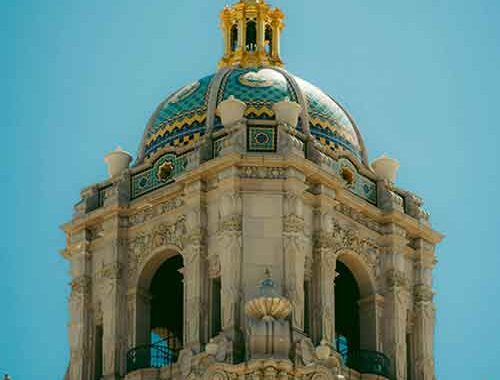Historic Building Seat of City Government
Touring Beverly Hills you can’t help but notice that art deco building in the heart of the city. The meticulous artwork and adornments draw your eye to it like no other edifice in Beverly Hills. That’s the City Hall building and it’s got a great history.

Beverly Hills City Hall building on bus tour
Beverly Hills City Hall, nestled in the heart of one of Los Angeles’ most prestigious neighborhoods, stands as an architectural masterpiece and a symbol of civic pride. With its iconic Spanish Renaissance Revival design and rich history, this landmark building embodies the spirit of Beverly Hills while serving as the administrative center for the city’s government. In this exploration, we delve into the origins, architecture, significance, and cultural impact of Beverly Hills City Hall, tracing its evolution from a visionary concept to a beloved icon of the community.
Origins and History
The story of Beverly Hills City Hall traces back to the early 20th century when the city’s rapid growth necessitated a centralized administrative hub. In 1925, the Beverly Hills Civic Center Site was acquired, laying the foundation for the construction of a municipal complex that would reflect the city’s aspirations for sophistication and elegance. Architectural plans were commissioned, and after meticulous deliberation, renowned architect William Gage was chosen to design the new City Hall building, incorporating elements of Spanish Revival architecture to harmonize with the surrounding landscape and reflect the city’s unique character.
Architectural Design
Completed in 1932, Beverly Hills City Hall is a testament to Gage’s architectural prowess and attention to detail. The building’s façade is adorned with elaborate ornamentation, including intricately carved stonework, arched windows, and decorative tiles that evoke the grandeur of Spanish colonial revival style. A central bell tower rises majestically above the structure, crowned with a distinctive dome that serves as a prominent landmark on the Beverly Hills skyline. The interior spaces are equally impressive, featuring elegant halls, vaulted ceilings, and richly appointed chambers that exude an air of refinement and sophistication.
Cultural Significance
Beyond its role as a seat of government, Beverly Hills City Hall holds a special place in the hearts of residents and visitors alike. Its timeless beauty and historical significance make it a popular destination for architectural enthusiasts, tourists, and filmmakers seeking to capture the allure of Old Hollywood glamour. Over the years, the building has served as a backdrop for countless movies, television shows, and cultural events, further cementing its status as an iconic landmark synonymous with the spirit of Beverly Hills.
Community Engagement and Services
Beverly Hills City Hall is more than just a government building; it is a vibrant community hub that offers a wide range of services and amenities to residents and visitors. From city council meetings and public hearings to cultural exhibitions and educational programs, the building plays host to a diverse array of events and activities that foster civic engagement and community cohesion. Additionally, City Hall houses various administrative offices, including those responsible for planning and zoning, public works, and community development, ensuring that essential municipal services are readily accessible to those in need.
Preservation and Restoration Efforts
In recent years, Beverly Hills City Hall has undergone extensive preservation and restoration efforts to ensure that its historic integrity is preserved for future generations. These initiatives have involved meticulous restoration of architectural features, such as the building’s ornate façade, interior finishes, and decorative elements, as well as upgrades to modernize infrastructure and improve accessibility. Through collaboration between city officials, preservationists, and community stakeholders, Beverly Hills City Hall continues to stand as a shining example of historic preservation and adaptive reuse, honoring the legacy of its creators while embracing the evolving needs of a dynamic city.
Conclusion
Beverly Hills City Hall stands as a testament to the enduring legacy of one of Los Angeles’ most iconic neighborhoods. With its timeless beauty, architectural splendor, and rich history, this landmark building embodies the spirit of Beverly Hills while serving as a vital center of governance, culture, and community life. As it continues to evolve and adapt to the changing needs of the city, Beverly Hills City Hall remains a cherished symbol of civic pride and a beacon of elegance in the heart of Southern California.


